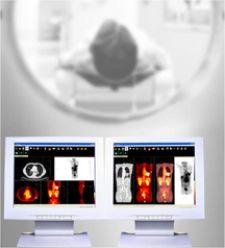
Merge acquired Cedara Software to converge IT and clinical applications.
Radiology is currently experiencing a very volatile state, as advancements in device technology are creating a new landscape of competition. Information technology (IT) and equipment are expanding the reach of the radiologists to new therapeutic techniques.
As technologies such as enterprise-wide connectivity and molecular medicine merge, and the role of radiology overlaps with other medical domains, the medical imaging industry follows suit, and is rapidly consolidating.
Like all specialties, radiology cannot stand alone, yet it differs in that it feeds other clinical fields. The modern surgeon relies on images to plan and navigate during surgical prodedures. The cardiologist utilizes multidetector CT (MDCT) as a new minimally-invasive weapon in their arsenal to detect cardiovascular disease. The lines of demarcation between the radiation oncologist and radiology are blurring, with oncology’s advanced technologies becoming more dependent upon the images that radiology produces.
In RSNA president’s David H. Hussey, M.D., address at RSNA 2005, he encouraged attendees to embrace interaction and communication between diagnostic and therapeutic specialties. “It is clear to me that medicine is more effective when physicians from different specialties interact and work toward the goals of faster and more accurate diagnosis, better treatment and periodic assessment of treatment outcome,” said Dr. Hussey.
Industry Consolidation
Unlike the acquisitions of past years, the goal for many companies is not just to strengthen a presence by increasing the breadth of radiologic technologies, but rather to open new business channels by venturing beyond radiology. In the late 1990s, Siemens demonstrated vision with its acquisition of SMS (Shared Medical Systems), and recent acquisitions and partnerships are following that lead. When Philips entered into a strategic alliance with Epic in late 2003, only one of the “big three” did not have an end-to-end IT solution. In a joint-statement, Philips and Epic said that the partnership was created to “provide enterprise software, medical imaging and monitoring IT solutions that will integrate patient information enterprise-wide.” The Holy Grail is no longer the ability to implement an enterprise-wide PACS and make images available wherever and whenever needed, rather it is the creation of the electronic health record (EHR).
GE resolved its end-to-end issue in the fall of 2005 with its announced acquisition of IDX. “GE and IDX have a shared vision on how to accelerate the adoption of electronic health records across the globe,” said Joe Hogan, president and CEO of GE Healthcare at the time of the announcement.
The trend to provide EHR is further apparent in the convergence of radiology PACS with cardiology PACS. Both the McKesson/Medcon, Agfa/Heartlab and Emageon/Camtronics purchases highlight the emerging philosophy of an integrated, multidisciplinary image management and distribution network. The real challenge that lies ahead is the integration of these systems on the back end, with a common database and shared archive.
More challenging than radiology or cardiology PACS is the movement of this technology beyond these traditional specialties. Visible light, or optical light, allows for image acquisition outside of radiology, thus broadening the reach and utility of PACS. As McKesson demonstrated in its booth at RSNA, visible light appears to be the next wave in imaging. (More on this topic can be found in the Visible Light series published by this magazine.)
The Rise of Molecular Medicine
As important as the EHR and enterprise-wide connectivity is to healthcare, so too is the rapidly emerging world of molecular medicine. GE blazed this trail with the Amersham acquisition in late 2003. The partnership speaks volumes on the future of radiology and more broadly, medicine. “Amersham’s diagnostic pharmaceutical and life sciences business will add new, high-growth platforms to GE Healthcare’s diagnostic imaging, services and healthcare information technology businesses. The combination of this technological and market knowledge will allow GE to accelerate the development of molecular imaging and personalized medicine where it will be possible to predict and treat disease with therapies tailored to the individual,” said Jeffrey R. Immelt, chairman of the board and chief executive of General Electric upon announcing the acquisition in 2003.
It was no surprise when Siemens commenced a cash tender offer for CTI Molecular Imaging in the spring of 2005. The joint venture between CTI and Siemens through the formation of CPS Innovations in 1987 ran its course before Siemens exercised its quick call option for CPS that was a part of the original agreement. This action, plus the formation of Siemens’ molecular imaging division last June, further guarantees these two companies will compete at a molecular level.
Another important, yet not as widely reported, acquisition is the recent activity at Merge Healthcare. By acquiring Cedara Software, Merge is leading the industry into a new arena, where IT and clinical applications converge. Kodak also possesses both CAD (mammography) and PACS technology. Just as 3-D post processing has finally been embedded into PACS, so too is the possibility that CAD and other intelligent software applications will enable a more functional and knowledgeable enterprise-wide PACS. It will be interesting to see how, or if, both companies charge into new territory by combining intelligent systems, such as CAD, with PACS.
The Holy Grail – EHR
Making healthcare efficient and effective requires access to information throughout the enterprise. Yet, much of this information lies outside the realm of a radiology department or hospital. Most insured patients first visit their primary care physician or, in some cases, an urgent care center. Clinical specialties other than radiology manage the patient, yet rely upon diagnostic imaging to facilitate disease detection and monitor treatment. As the trend continues to move services to lower cost facilities such as outpatient imaging centers, Rich Linden, president, Merge Healthcare, believes that there is a huge opportunity for these imaging centers to think more broadly and change the clinical services model. It is possible that the imaging center of the future will become a multispecialty group practice where diagnostic and therapeutic procedures converge.
If medical services continue to expand beyond the four walls of a central facility such as a hospital, the EHR takes on critical importance. “The EHR will help integration and interoperability,” said Peter McClennen, president and CEO of Amicas. McClennan further sees wireless technologies as an important tool for accessing the EHR.
The image-rich EHR is a primary goal, according to Robert Prior, president of Agfa Healthcare North America. “It is not about radiology, rather bringing all images together on a single platform,” he added. The continued push toward enterprise-wide integration is central to his company’s vision of the future, facilitated by Web-enabled, smart client technology that does not possess the same limitations as thin client technology.
Only with advanced Web integration capabilities will healthcare integration occur, emphasized Robert Cooke, Fuji’s executive director of Marketing, Network Systems. Cooke further stated that the EHR will be the portal through which intelligent and advanced visualization technologies will be accessed and adapted into clinical use.
At this year’s RSNA, it was evident that PACS/IT companies understood the importance of the clinical portal, as numerous vendors touted their solution’s portal or digital dashboard for referring physicians. This trend is redefining PACS and subtly moving the management of images into the domain of the IT department.
Proliferation of Images and Data
MDCT is one of the fastest growing segments of medical imaging. As discussed at the RSNA’s opening session, “Multidetector CT: Beyond 16 Slice—Too Much of a Good Thing,” John M. Boone, M.D., professor, departments of Radiology and Biomedical Engineering, University of California, Davis, said that 64-slice CT “represents a revolutionary increase for what the radiologist can use these scanners. Agreeing with Dr. Boone, Eliot K. Fishman, M.D., professor, Radiology and Oncology, and director of Diagnostic Radiology and Body CT at Johns Hopkins Hospital, Baltimore, stressed the importance of MDCT as the clinical application that enables better patient care and diagnosis.
With the increasing number of slices CT’s can carve out, many medical professionals have asked “how many slices are enough?” According to Doug Ryan, director, CT Business Unit, Toshiba America Medical Systems, the detector
material is the same up to 64 slices. To make the quantum leap to 256 slices, the technology must be validated by demonstrated clinical use and utility. Ryan does believe the next evolution in CT will be cone-beam CT, which may have the potential to perform myocardial perfusion studies.
Innovation in imaging systems is driving change within radiology, insisted McClennan, who added, “Now, film is not practical.” Most notably, the overwhelming amount of information requires the industry to address radiology workflow and the impact of advanced visualization and image processing applications.
“We must free the hands of clinicians to deal with patients,” said Gene Saragnese, vice president and general manager, Global Molecular Imaging and CT, GE Healthcare.
With the explosion of image and data generation in healthcare, there is a paradigm shift toward the implementation of intelligent systems along with IT, which quite possibly encompasses virtual reality, CAD and advanced image processing tools such as fusion or 3-D and 4-D graphics.
Therapeutic Modalities
When GE Healthcare launched its MR-guided focused ultrasound (MRgFUS) at the 2004 RSNA through its partnership with InSightec, MRI entered a new arena as a therapeutic device. Under MR guidance, the ExAblate 2000 uses high intensity ultrasound beams to heat and destroy uterine fibroid tissue. According to Lynn Golumbic, director of Marketing, InSightec, a phase II study with 200 sites is investigating the systems’ use for necrosis of breast tumors. The goal, Golumbic says, is for this technique to be clinically validated to replace lumpectomies.
Ablation is another hot topic today. A large-scale, 12-year study presented at RSNA found that laser ablation with MR guidance is as effective as traditional surgery in the treatment of liver tumors in some patients. MR-guided laser-induced thermotherapy (LITT) on 839 patients at the University of Frankfurt in Germany found the average survival rate of 3.8 years favorable compared to traditional surgery rates of between 1.5 and five years.
Lead author of a study on noninvasive ablation, Martin Mack, M.D., associate professor, department of Diagnostic and Interventional Radiology, University of Frankfurt, said, “I believe that minimally invasive tumor ablation together with chemotherapy will play the most important role in the treatment of tumors in the years to come.” Dr. Mack also stated that he believes that local ablation can potentially replace traditional surgery as the treatment standard for tumors throughout the body.
Yet not all diseases can be treated in a minimally invasive manner, and when surgery is required, there remains an important role for modalities. In fact, Siemens Medical Solutions took this concept a step further at RSNA 2005 by introducing NaviVision, a surgical C-arm and optical 2-D/3-D navigation unit on a common platform. NaviVision brings together two products: BrainLAB AG’s integrated optical navigation and Siemens’ ARCADIS family of mobile C-arms.
“Surgical navigation is an essential step in linking intraoperative image data directly with surgical actions and clinical workflow in the OR,” said Denise Lippy, vice president, Special Systems Division, Siemens Medical Solutions.
Therapeutic modalities will create new opportunities and challenges for radiology. While the potential exists for radiologists to venture into a new subspecialty – a therapeutic radiologist that delivers treatment with MR-guided ablation, for example – there is also concern that certain imaging studies are leaving the domain of radiology. This issue must be addressed by the industry in conjunction with our government’s concern that the age of advanced imaging is partly to blame for skyrocketing healthcare costs. The potential of medical imaging has only been partially tapped.
Seeing is Believing
How will imaging systems help transform medicine? “Imaging will transition from millimeters to molecules,” said Sargenese. “We must leverage biology to peer deeper into the pathways of disease. That will make the difference.”
The merging of biology and radiology, and the subsequent emergence of molecular medicine, will transform healthcare in the next decade. Saragnese foresees a new language of medical communication, one between engineers, medical physicists and biologists; a symbiotic relationship focused on disease management that will determine the direction of technology for the next generation.
Perhaps most exciting is the development of new biomarkers that will pinpoint active pathways in the disease progression, further helping physicians to understand how a particular disease responds to therapy and enabling the personalization of treatment based upon the individual’s reaction to treatment protocols.
With its newly formed division, Siemens Medical Solutions is stepping up its efforts and is better poised today to pursue new biomarkers with the addition of PETNET Solutions from its CTI acquisition. Michael Reitermann, president, Molecular Imaging Division, Siemens Medical Solutions, said, “We are moving from treating the illness to treating the patient, utilizing tools from leading-edge hybrid scanners that detect abnormalities before symptoms appear to new biomarkers for identifying disease pathways.”
How significant is the paradigm shift to molecular medicine? “New agents will, in many ways, shape how we treat patients,” Saragnese said. “Therapies will change and shape new diagnoses and the eventual thrust will move treatment forward” in the cycle of disease management and healthcare.
Part of this future is the continued evolution of hybrid imaging. Reitermann believes that continued development of trial hybrid modalities is extremely important to the field of molecular imaging. Without molecular imaging, many highly anticipated advancements, such as new tracers and biomarkers, would not be possible since the development of these are inextricably tied to preclinical studies utilizing microPET, microCT and microSPECT.
Certainly, the role of imaging is critical to visualizing normal and abnormal cells by identifying radionuclides attached to tracers. Siemens Medical Solutions lists three different evolving technologies on its Web site: radionuclide imaging (radionuclide probes); magnetic resonance imaging (paramagnetic labeled probes); and optical imaging (fluorescent and bioluminescent probes).
The Softer Side
Closely tied to molecular imaging hardware are image fusion and reconstruction software. There will be deformable and rigid fusion for virtually all modalities. It will not be uncommon to fuse multiple images or two MR images for example, if the information gleaned assists in a more accurate diagnosis. Deepal Malhotra, senior director, Marketing and Business Development, Nuclear Medicine, Philips Medical Systems, added that “advances in image reconstruction have improved spatial resolution, enhancing a physician’s ability to detect smaller lesions.”
However, as with image fusion, the limiting factor for 3-D reconstruction techniques has been computing power “Dramatic increases in processing speed have enabled improvements in 3-D reconstruction methods and times,” commented Jim Cavanaugh, director, Product Marketing, Nuclear Medicine, Philips Medical Systems.
Information-based medicine is also part of the future, according to Doug Johnson, manager, Medical Imaging, Americas, Healthcare & Life Sciences Industry Solutions for IBM. Johnson’s division is working with hospitals to simplify infrastructure and address business continuity, which he says, “is more critical as hospitals advance technologies and become reliant upon their infrastructure.” Johnson also sees automation as a driving force in healthcare’s future, particularly as it applies to information lifecycles. “It must be automated,” said Johnson. “Hospitals will generate pedabytes of data within three years of going digital.”
The New Architecture of Imaging
The state of the imaging industry is on the verge of transformation. Information technology will reign, and advanced applications such as image fusion and reconstruction along with the push for the EHR will require the digitization of medicine. PACS is no longer a “may have” but a “must have.” The real question is what will PACS become in the next five years? Image management must expand beyond the walls of radiology for effective,
efficient healthcare.
What we can see today is that the era of noninvasive therapies has begun, and as we enter the molecular age, images and information must coexist together to provide a complete picture of a patient’s total health. Seamless integration that includes system interoperability, integration and enterprise-wide access is the key to success.




 December 10, 2025
December 10, 2025 









